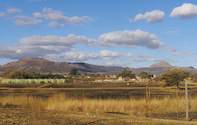Town on the Amajuba Route
Named after the well-known city in Holland, the small town of Utrecht in KwaZulu-Natal on the Amajuba Route is a place with much to offer the fortunate visitor.

Tucked away in a corner of the picturesque Balele Mountains, Utrecht is a rare gem, unique in that it lies in the heart of a Game Park.
The Utrecht Balele Community Game Park surrounds the whole town of Utrecht and therefore literally makes Utrecht a Town Within a Game Park with no fences between the town and the game park.
The Utrecht Balele Community Game Park is a must for the birder visiting this region, as there is a range of species not normally encountered in the grassveld biosphere biome. Sightings include Fiscal Flycatcher, Golden Breasted Bunting, Plum-coloured Starlings, Crowned Eagles and Marshall Eagles.
Utrecht does not only offer an historical experience to visitors. The picturesque Balele Mountains with their waterfalls and diversity in ecology are home to rich bird life and variety of fauna in the Balele conservancy that encircles the town.
Utrecht has excellent agricultural potential and is the most important wool-producing area in KwaZulu Natal. It is, however, also a major cattle and mixed farming region. Farm holidays are on offer to the city dweller in search of an alternative experience.
Utrecht is indeed both unique and unexpected; nestling in a corner of the Balele mountains, this small town has so much to offer visitors.
An Historical Perspective
Utrecht was established by Voortrekkers in 1847, and was one of five original Voortrekker settlements established prior to 1850.
A group of Voortrekkers settled along the Buffalo River much against the wishes of the Transvaal Government, who thought the British might consider this proximity as a provocation. This community then gave the ruling Zulu King 100 head of cattle in exchange for grazing rights in a large area.
They elected their own government and named their ‘capital’ and ‘country’ Utrecht, after the city in Holland. The little republic then chopped and changed its allegiance several times. They soon realised that they could not really support independence, and approached the Transvaal Government asking to be incorporated into Transvaal.
This was refused and it was the Republic of Lyndenburg that incorporated Utrecht. Four years later when Lyndenburg rejoined the Transvaal Republic, they took Utrecht with them. At the end of the Anglo-Boer war Utrecht was returned to Natal, now re-named KwaZulu-Natal, where it seems likely to stay.
Utrecht was prominent during the Anglo-Zulu War of 1879, when for several weeks it served as British HQ for both Commander-in-Chief Lord Chelmsford and Colonel Evelyn Woods' famous 'Flying Column'.
 The Utrecht Balele Community Game Park in Utrecht, Kwazulu-Natal, South Africa covers an area of over 2500ha and is stocked with no fewer th...
The Utrecht Balele Community Game Park in Utrecht, Kwazulu-Natal, South Africa covers an area of over 2500ha and is stocked with no fewer th... In spite of its small size, Utrecht in KwaZulu-Natal, South Africa is a historical gem with ten National Monuments and 10 historical sites....
In spite of its small size, Utrecht in KwaZulu-Natal, South Africa is a historical gem with ten National Monuments and 10 historical sites....